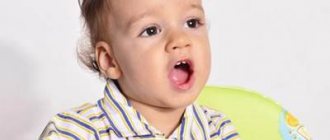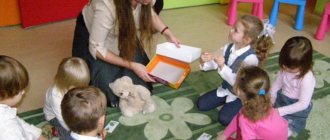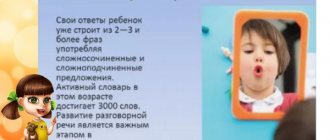Problems of speech development of preschool children at the present stage
Marina Buravikhina
Problems of speech development of preschool children at the present stage
Speech is a great gift of nature, thanks to which people receive ample opportunities to communicate with each other. Speech unites people in their activities, helps to understand, shapes views and beliefs. Speech provides a person with a huge service in understanding the world.
However, nature gives a person very little time for the emergence and development of speech - early and preschool age . It is during this period that favorable conditions are created for the development of oral speech , the foundation is laid for written forms of speech (reading and writing)
and subsequent
speech and language development of the child .
The standard identifies 7 components of speech development .
1. Mastery of speech as a means of communication and culture
2. Enrichment of the active vocabulary
3. Development of coherent speech (dialogical, monological)
4. Development of speech creativity
5. Development of sound and intonation culture of speech, phonemic hearing
6. Acquaintance with book culture, listening comprehension of texts of various genres of children's literature
7. Formation of sound analytical-synthetic activity as a prerequisite for learning to read and write
Having studied the target guidelines at the stage of completion of preschool education , we see that speech development accompanies all types of child activities.
Speech development of a preschooler is the most important of all educational areas. No less important is cognitive or physical development , artistic-aesthetic or social-communicative. But is it possible for children to fully develop in any of these educational areas without speech, without communication, without communicative activities? Cognitive development always involves numerous questions and answers, explanations, problem , clarification, and reading. Physical development cannot do without rules, commands and explanations, and artistic and aesthetic development cannot do without artistic images, poems, literary texts, and their discussions. Already in the very name of the socio-communicative field there is a need to use speech means to implement the intended tasks. there is no point in arguing about the place of speech development
What is the state of speech development at the present stage ?
The 21st century is the century of computer technology. Children, it would seem, have everything for their development : computers, phones, televisions, but for some reason more and more children are found with speech disorders .
Typical speech development problems of a preschooler :
-Monosyllabic speech consisting only of simple sentences (so-called “situational” speech)
. Inability to construct a common sentence grammatically correctly.
-Poverty of speech. Insufficient vocabulary.
- Littering speech with slang words (the result of watching television programs, using non-literary words and expressions.
-Poor dialogical speech: inability to formulate a question competently and clearly, to construct a short or detailed answer , if necessary and appropriate.
-Inability to construct a monologue: for example, a plot or descriptive story on a proposed topic, retelling the text in your own words. (But it is simply necessary to acquire this skill before school)
-Lack of logical basis for your statements and conclusions.
-Lack of speech culture skills: inability to use intonation, regulate voice volume and speech rate, etc.
-Bad diction.
In general, the level of speech development in modern preschool children can be characterized as unsatisfactory. This problem is urgent .
Speech disorders make communication difficult, negatively affect mental activity, lead to changes in the child’s emotional sphere, and limit the acquisition of conceptual meanings and speech patterns .
What's the matter? What influences the development of children's speech ? Ecology? Bad habits of parents? Birth injuries or maternal illness during pregnancy? Various diseases of children? Pedagogical and social neglect? Or maybe both, and the third? There are many reasons. But if the child is healthy, then the main reason is, unfortunately, pedagogical and social neglect.
Let's try to figure it out.
development begins in the family. And parents themselves “enslave their child’s speech development ”
and they themselves don’t notice it. What does it mean?
Overprotection. The child was born. Parents strive to comply with sanitary and hygienic standards, diet, and provide all kinds of toys. They anticipate the baby’s wishes and do not allow him to try to answer the question; they give suggestions and finish everything for him.
Anxiety. When eating, they are afraid that the child will choke and grind the food, thereby hindering the development of the muscles of the speech apparatus .
Child's protest due to excessive pressure from adults. Say, repeat, no, it needs to be like this. Or vice versa! Shut up! Shut up! Such actions lead to speech closure - speech negativism , and subsequently to speech delay.
Pacifier, diaper and tablet! A child starting to explore the world asks questions, cries, screams. Not all parents agree to tolerate it. A pacifier in such a situation is an easy way to save your own nerves, just like a diaper. There is no need to make any effort.
Another situation. tastes everything . Let's just say - everything goes into your mouth. The solution is a pacifier.
In early preschool age, you need to communicate with your child. Read together, learn poems and nursery rhymes. Do finger exercises, collect pine cones in the forest, sort through buttons and beans. Play with your child. But parents believe that these are outdated methods. We live in the modern world and children need modern toys , and of course, tablets, phones, TVs. It's convenient. Give him a tablet, insert a pacifier and go about your business. And the child is left to his own devices.
Advanced development ! You need to know not only Russian, but also English or some other additional language, or maybe two. Yes, and at four years old you need to read.
In general, there are a lot of such problems .
But the child entered kindergarten. a role in speech development . Both in normal and pathological conditions, speech development is a complex and diverse process. Children do not immediately and suddenly master the lexical and grammatical structure, syllabic structure of words, sound pronunciation, and inflection. Some language groups are acquired earlier, others much later. Therefore, at various stages of development of children's speech, some elements of the language have already been acquired, while others have not yet been acquired or are only partially acquired. Hence such a variety of violations of conversational norms by children. Therefore, development in kindergartens. The kindergarten program sets the teacher the task of teaching each child to express their thoughts meaningfully, grammatically correct, coherently and consistently. The child’s speech should be lively and emotionally expressive.
We teachers are obliged to create the most favorable conditions for this, that is, a speech development environment . What it is? This is not only the subject environment, but also the role of an adult in organizing influence on the development of various aspects of a preschooler’s . But methodological tools will help with this. Which?
There are a number of them.
• communication between adults and children, development of communication skills;
• cultural language environment, teacher’s speech;
• classroom learning;
• fiction, various types of art (fine, music, theater)
.
• modern technologies and methods.
1. The most important means development is communication.
Communication is the interaction of two or more people aimed at coordinating and combining their efforts in order to establish relationships and achieve a common result. Speech occurs at a certain stage in the development of communication . It does not arise from the very nature of the child, but is formed in the process of his existence in the social environment.
development begins from birth and continues intensively throughout preschool age . Preschool age is a period of active acquisition by a child of spoken language, the formation and development of all aspects of speech : phonetic, lexical, grammatical. Full command of the native language in preschool age is a necessary condition for solving the problems of mental education of children.
Speech communication in preschool age is carried out in different types of activities: in play, work, household, educational activities and acts as one of the sides of each type. Therefore, it is very important to be able to use any activity develop
Communication with peers in preschool age plays no less important role in the development of children than communication with adults.
When communicating with peers, children more actively use speech skills . The greater variety of communicative tasks that arise in children’s business contacts creates the need for more diverse speech means .
An analysis of children's behavior showed that the presence of an adult stimulates the use of correct speech; they begin to speak only in a communication situation and only at the request of an adult. Therefore, it is recommended to talk with children as much and as often as possible. Teachers should encourage children to turn to adults with questions, judgments, and statements; Encourage children to verbally communicate with each other , give instructions and instructions.
Practice dialogue with the child, ask simple questions and ask to show and name objects and their properties. You need to talk constantly.
An analysis of practice shows that not all educators know how to organize and use communication in the interests of children’s speech development . An authoritarian style of communication is widespread, in which instructions and orders from the teacher predominate. Such communication is formal in nature and devoid of personal meaning. More than 50% of the teacher’s statements do not evoke a response from the children; there are not enough situations conducive to the development of explanatory speech , evidence-based speech, and reasoning. Mastering culture, a democratic style of communication, and the ability to provide so-called subject-subject communication, in which interlocutors interact as equal partners, is the professional responsibility of a kindergarten teacher.
2. The speech of an adult is an example to follow.
A child’s speech develops largely as a result of imitating the speech of others. Adults need to watch their speech. Of particular importance is the speech of the teacher, who is constantly with the children; he is the most authoritative person for them. Every teacher should know that in kindergarten his speech turns into a pedagogical tool, into an instrument of influence on children
It should be borne in mind that by imitating adults, children adopt not only advantages, but also disadvantages. This is where the requirements for adult speech have developed:
-Speech must be meaningful, logical and accurate.
-Must be accessible (appropriate for the child’s age)
.
-Speech must be lexically, phonetically and grammatically correct.
-A literary word must be used in speech.
-Speech must be expressive.
-The speech should be emotionally rich.
-An adult should not rush when talking to a child. -The words are pronounced loud enough for the child to hear all the sounds.
-An adult must know and observe speech etiquette .
-In speech, an adult must use verbal and nonverbal means of communication.
-The words of an adult must correspond to his deeds.
The most important form of organizing speech and language teaching in the methodology is considered to be special classes in which certain tasks of children’s speech development . Without special training sessions, it is impossible to ensure the speech development of children . The teacher purposefully selects the material that children have difficulty mastering and develops those skills and abilities that are difficult to develop in other types of activities. In the classroom, in addition to the teacher’s influence on the children’s speech, the children’s speech interacts with each other.
Team training increases the overall level of their development .
Educational activities are organized on the basis of a program from birth to school and partial programs in accordance with the requirements of SanPin. The basic invariant part is supplemented by developmental and club activities, such as preparation for learning to read and write in the senior and preparatory groups (2 r / r and literacy, preparatory for school - logorhythmics, the younger group - the Teremok
(folklore-patriotic direction)
.
4. Fiction is the most important source and means of developing all aspects of children’s speech and a unique means of education. It helps to feel the beauty of the native language and develops figurative speech .
Children's books are considered as a means of mental, moral, and aesthetic education. In essence, a literary work provides ready-made linguistic forms, verbal characteristics of the image, definitions with which the child operates (i.e., a small child masters the grammatical norms of the language)
. In fairy tales, children learn accuracy and expressiveness of speech. From the book, the child learns many new words and figurative expressions, his speech is enriched with emotional and poetic vocabulary.
We begin to introduce children to fiction with miniatures of folk art - nursery rhymes, songs, then we listen to folk tales, which are useful to retell.
Reading leads to various forms of work in which speech develops : learning poems, retelling, dramatizing fairy tales, etc.
In this way, children develop the ability to hear and understand speech, enrich their vocabulary, develop monologue speech and its intonation side, expressiveness. Reading fiction is carried out daily in joint activities with children.
6. In order to ensure the development of the personality of pupils, it is necessary to create a developing subject-spatial environment in each age group. “ The developing subject-spatial environment must be meaningful, rich, transformable, multifunctional, variable, accessible and safe. The richness of the environment must correspond to the age capabilities of the children and the content of the Program.
One of the important conditions when creating a developing subject-spatial environment is the correspondence of the material to the age of preschoolers . Compliance with age is one of the significant and at the same time difficult conditions to fulfill. There is the concept of speech norm , i.e., an age-related characteristic of a child’s speech, which includes a description of speech development at a particular age. Moreover, these descriptions contain average statistical information. But we work with real people, whose speech has its own individual characteristics and pace of development . Therefore, the next age group is the custodian of the environment of the previous group. It must preserve materials from the previous stage of development .
Working with parents.
Work on the development of speech and verbal communication of preschool children should be carried out not only in the conditions of preschool educational institutions, but also in the family. Parents must independently work with their children, in accordance with the goals of the children’s speech development , taking into account the age of the child.
In the arsenal of pedagogical practice, there are many methods and techniques, technologies and techniques for developing the speech of preschoolers , both traditional and modern-innovative .
Among the innovative technologies and methods, we use the following: design and research activities, ICT, triz technology, logorhythmics, fairy tale therapy, mnemonics, syncwine, cluster, laptop, etc.
But modern forms of work in kindergarten do not deny traditional ones, but they are improved, modernized, and supplemented. And they are created at the moment in accordance with the requirements of the time. This corresponds to the tasks set at the state level, as evidenced by the concept of modernization of education. When you use something new and interesting in your work, you get carried away, and, accordingly, you get the children interested, and when this activity brings a tangible, visible result, it’s doubly interesting and exciting.
In order for the program tasks of organized learning to be solved more successfully, it is necessary to make the entire day of the child’s stay in kindergarten more meaningful in terms of speech development . The richer and more meaningful the impressions of everyday life, the greater the cognitive opportunities available for study.
What kind of activity can ensure familiarization with the environment and the development of a child’s active speech?
First of all, joint activity between an adult and a child, during which emotional contact and business cooperation are established. It is important for the teacher to organize joint actions so that he can call the child for verbal interaction or find lively, accessible reasons for the child to communicate.
In the process of joint activity, the teacher does not set tasks for direct speech teaching, as is done in the classroom. The formulation of problematic language tasks here is situational in nature.
There are a large number of forms of joint activities. Today we invite you to look at, in our opinion, the most interesting, most effective, activating speech activity . This is, of course, a play activity!
Brain and speech
The human brain is directly responsible for the functioning of the speech apparatus. It is here that there are special zones that transform what is heard into full-fledged information that the child can receive, interpret and give back. Also, it is in the brain that there are zones that are responsible for the functioning of the speech apparatus - they make the ligaments and its other components work.
Sometimes the smooth functioning of the brain can be disrupted, and then the child begins to have problems with speech. And this is not uncommon.
Article on the topic
Giving birth is not harmful. Why are late children often talented?
Why does the child speak poorly?
In the vast majority of cases, speech problems are associated with birth trauma. A difficult birth with complications always leaves an imprint on the health and behavior of the newborn. Even if the problem is not immediately noticeable, with each month and year of the child’s life it becomes more and more obvious.
A displacement of the skull bone even by a millimeter is already mechanical damage, which will entail a number of consequences. If the bones of the base of the skull are displaced, namely the occipital bone, then the entire spine begins to adapt to it, and this chain stretches all the way to the feet. A bone displaced from its place loses mobility, the flow of arterial blood to some areas of the brain is disrupted, and, accordingly, the brain and areas responsible for speech functions lack nutrition.
Disruption of the blood supply to the nuclei of the cranial nerves (facial, trigeminal, hypoglossal, glossopharyngeal, vagus) leads to disruption of the muscles controlled by these nerves and involved in pronouncing words. The nuclei of these nerves are located in the brain stem. Therefore, disruption of the blood supply to the trunk directly affects their work. And the trunk receives blood from the vertebral arteries, which, in turn, suffer during birth trauma.
Flu in position. How does it threaten the expectant mother and her child? More details
Due to the injury, the hypoglossal nerve (in the canal of the hypoglossal nerve), as well as the glossopharyngeal and vagus (in the jugular foramen) can be pinched. Finally, as a result of the injury, the function of the brain as a whole suffers, since the blood supply and circulation of cerebrospinal fluid in the cranial cavity and spinal canal are disrupted. Thus, the coordinated work of all areas of the brain involved in speech is disrupted: the associative neural connections of the auditory analyzer, the areas responsible for recognizing oral speech and for the sensation of the movement of one’s own muscles (proprioception).
Facial, chewing muscles, tongue muscles, jaws, teeth - these are those parts of the speech apparatus that reproduce sounds. Their good condition is important for correct articulation. This is why speech therapists successfully use special massage to improve the functioning of the tongue and lips.
Other manifestations of birth trauma become frequent accompaniments of speech impairment. On the part of the nervous system, these may be excitability, outbursts of aggression, capriciousness, tearfulness, restlessness, inability to concentrate, sometimes a tendency to withdraw into oneself, self-absorption, and reluctance to contact others. Symptoms may also include stooping, chest deformation, scoliosis, etc.
Question answer
What is the right hemisphere of the brain responsible for?









